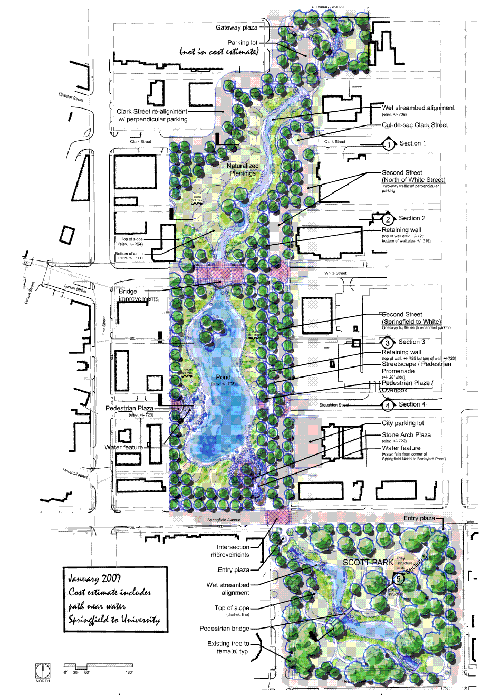City plans Boneyard Creek renovation
An architectural rendering shows the planned renovation of Boneyard Creek between Springfield Avenue and University Avenue in Champaign. Image courtesy of Hitchcock Design Group, Inc.
February 2, 2007
The Second Street reach of Boneyard Creek is set to receive a serious makeover.
In a Jan. 23 study session, the Champaign City Council directed the public works department to develop a final design, including improvements to Boneyard Creek through Scott Park and between Springfield and University Avenues.
Improving the Second Street reach, which should begin in 2008, is the second phase of a larger plan to provide adequate flood control throughout Boneyard Creek.
Dennis Schmidt, director of public works for Champaign, said that controlling Boneyard Creek floodwaters has caused the city problems for many years.
“You go back 10 years ago, we flooded Fourth and Green on a regular basis causing damage to the buildings and everything else,” Schmidt said. “In fact, there was a tremendous flooding problem there.”
Get The Daily Illini in your inbox!
Schmidt added that the first phase of the project, which included the Healey Street detention basin and improvements along the creek between Lincoln Avenue and First Street, has provided a great amount of relief to problems with flooding.
The decision did not come without debate, however. Two designs were presented to the council by the park district. The two plans were identical except for one distinguishable difference — one of these alternatives called for an above-ground detention basin north of White Street, while the other described below-ground detention, where excess water would be stored in large concrete conduits.
The above-ground detention concept, which the council backed 5-4, utilizes steeper slopes to achieve its flood control goal. The below-ground detention concept provides 1.6 acres more of usable flat space, but is $2.5 million more expensive than the above-ground concept.
Champaign resident Jerrold Soesbe said that an additional 1.6 acres of park space is well worth $2.5 million.
“What I’ve observed around (the Scott Park) neighborhood is an increase in housing, (there are) more and more people living in that area and park space is precious,” Soesbe said. “It’s a small price to pay for something that’s important in this area.”
Downtown Champaign businesses were also troubled by the above-ground detention concept. Brian Knox, owner of Knox-Array Event Production, 117 E. University Ave., said that businesses need things like access, availability and parking to survive.
“The current plan invades our downtown area, it impedes our rear access, and reduces the potential for any future growth, expansion, parking and the support services needed to grow and thrive,” Knox read from a petition put together by the downtown area’s east side businesses at the Jan. 23 meeting of the city council.
Knox also said that the north side of the park should be useful in order to stimulate growth in the area. He said that while the above-ground basin is functional in detaining floodwaters, it is not very useful when it is not filled with water.
“A big pit with trees is still a big pit,” Knox said.
Not all Champaign residents were adverse to the idea of above-ground detention, however. Champaign resident Dan McCollum said that an above-ground basin would be an aesthetic asset to the community, as there is plenty of flat area in Champaign available for recreational use.
The council originally voted on Jan. 9 to support the below ground detention of Boneyard Creek, which would create more usable park space. However, the council agreed to reconsider its decision when at-large council member Thomas Bruno noted that he was reconsidering his vote.
Although Bruno did not change his vote, the overall poll had changed in favor of the above-ground detention when the issue was considered the second time on Jan. 23.
“Either way we do this will benefit the community,” Bruno said. “We still have years to go on this project and opportunities to slowly tinker with what we have here.”
Bruno said that the decision is not yet set in stone. As the construction slowly moves upstream, it may be four or five years before work finally reaches the northernmost area in question.
“There will be plenty of opportunity to re-examine this,” Bruno said. “There are really two different approaches that both have some merit.”
Both concepts will provide major flood protection for Boneyard Creek, but it will not be cheap.
Estimated at $17.8 million, the above-ground detention project intends to provide an area aesthetically pleasing to the community.
“We’re kind of getting a second benefit out of a flood control project that ends up creating a park,” Bruno said.
“We do mean this to be an amenity,” said Council Member Michael LaDue, D-2. “We have it within our power and reach to make either of these choices an amenity.”
Bruno said that neither of the alternatives is a bad option. He said that while the below-ground detention is more recreational, the above-ground option is “recreational to the eye.”
“Some people go on vacation to the Grand Canyon just to look down into the big hole,” Bruno said. “This is still a park … It’s going to be a tremendous improvement to the area that connects campus to downtown.”







